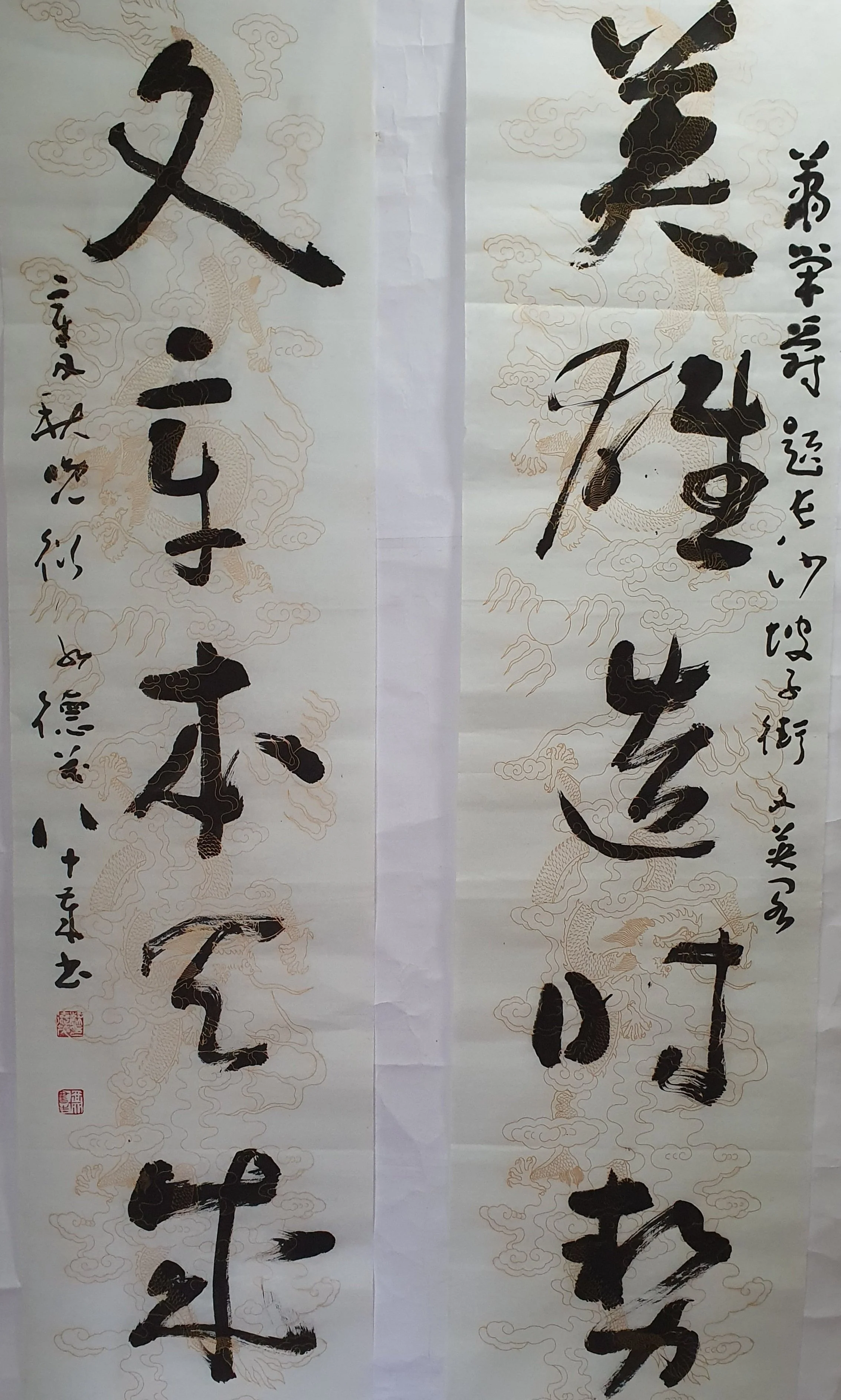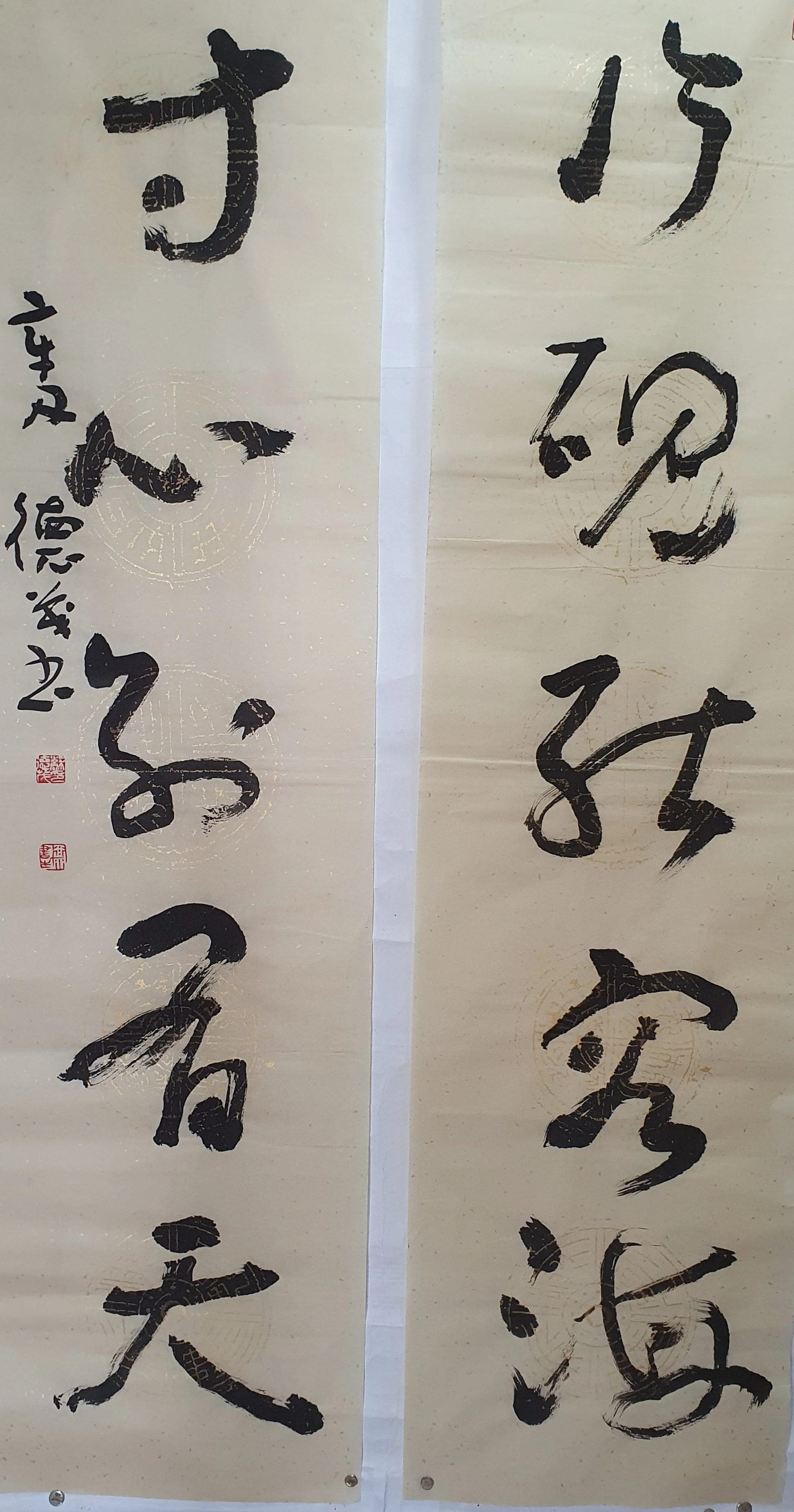对联 Couplets
对联又称楹联,最早出现于历史上称为五代时期, 有四言、五言、六言 、七言 、多言联, 明清时代较为兴盛, 文学上要求平仄对仗, 悬于正厅的两侧, 或门、或楹柱上,一般多用楷书、行书书写。
对联 or 楹联, also known as “Couplets”, is a type of calligraphy style that was first historically recorded during the Five Dynasties. It was then hugely popularized during the Ming and Qing dynasty period. These artworks are usually on two pieces of paper and are stylized to leverage the dynamics of words (antonyms, pronunciations, etc.). One of the papers would usually consist of multi-characters ranging between 4 and more words, with its matching paper consisting of an equal number of characters. They are usually written in either a regular or cursive calligraphy style.
Below are some examples calligraphed by Su Demao.
Do take note that in Chinese Calligraphy, words are read from right to left.
大海从鱼跃,天高任鸟飞
The ocean lets the fish leap, and the sky allows the birds to fly
“大海从鱼跃,天高任鸟飞“, “大海、长空”联最早见于清“诗人玉屑”, 传陈抟曾书, 齐白石也书写过。 讲人要放飞理想,如鱼、鸟在大海、在空中,自由生活,肆意地追求理想。
Everyone should pursue their dreams and ambitions with the same freedom and vigor as the fish in the ocean and the birds in the sky.
In summary, the idiom encourages people to pursue their ideals with the same freedom and passion as the fish that leap in the ocean and the birds that fly in the vast sky.
悬流排石出,落日送鸦归
See water dance, splashing stone with glee, As crows take wing, homeward bound at sunset's decree
“悬流排石出,落日送鸦归”, 此联写出日暮景象,写瀑布,写归鸦。 “县”即“悬”, 下联后三字为送鸦, 为集张迁碑字联。
The first line, "悬流排石出", describes the sight of the waterfall, with water cascading down and splashing against the rocks. "悬流" refers to the hanging or suspended flow of the waterfall, while "排石出" signifies rubbles rushing down with the water.
The second line, "落日送鸦归", depicts the sunset scene with crows flying back to their nests. "落日" means the setting sun, while "送鸦归" refers to the crows returning to their homes at night.
In summary, the couplet describes the beautiful scenery of a waterfall with the sound of splashing water and falling rubbles, and the sight of crows flying home at sunset, creating a peaceful and picturesque atmosphere.
尘外不相关几阅桑田几沧海,胸中无所得半是青松半白云
In the ever-changing mundane world, immersed in green pines and white clouds,
A tranquil and peaceful escape, detached and care-free, from the worldly plight
“尘外, 胸中”联: “尘外不相关几阅桑田几沧海,胸中无所得半是青松半白云”。 此联为庚子2020年三月我应朋友约, 所书成联。 前五字是上下联,为流水对, 后七字上下联,为句中对,此联对法少见,故此拈出。
上联讲主人不关心世事,不问人事及天地间之变化, 下联说主人无所事事, 自由生活于自己的小天地之间也。
此联用章草笔法书写。 这种样式的对联, 称为龙门对。
A state of mind where one is detached from the mundane world and lives freely in one's own small world. The first line expresses the idea that the person is not interested in the affairs of the world and is not affected by the changes that occur around them. The second line describes the person's inner world, which is peaceful and calm, like a forest of green pines and white clouds.










